HI6006 - Analysis of Key Strategy Development Tools in Business
VerifiedAdded on 2023/06/12
|5
|1061
|220
Essay
AI Summary
This essay provides a comprehensive overview of key strategy development tools, including SWOT analysis, PESTLE analysis, and Porter's Five Forces. It explains how these tools are used in business to analyze internal and external environments, identify competitive advantages, and make strategic decisions. The essay includes practical examples from companies like Amazon, Apple, and Nestle to illustrate the application of these tools in real-world scenarios. The SWOT analysis framework is discussed in terms of its focus on strengths, weaknesses, opportunities, and threats, while PESTLE analysis examines political, economic, social, technological, legal, and environmental factors. Porter's Five Forces analysis assesses competitive rivalry, the power of suppliers and buyers, the threat of substitutes, and the threat of new entrants. The document is available on Desklib, a platform offering study resources for students.
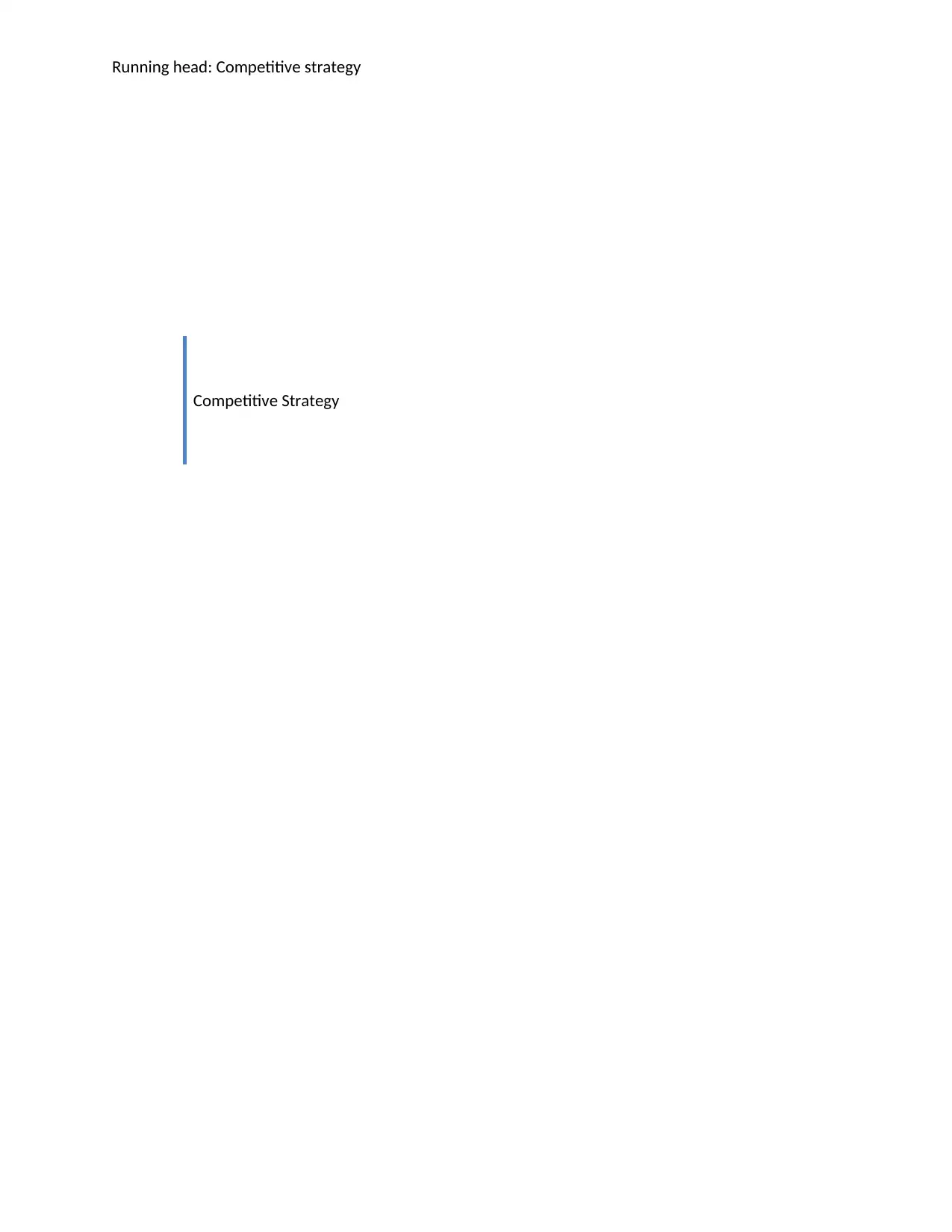
Running head: Competitive strategy
Competitive Strategy
Competitive Strategy
Paraphrase This Document
Need a fresh take? Get an instant paraphrase of this document with our AI Paraphraser
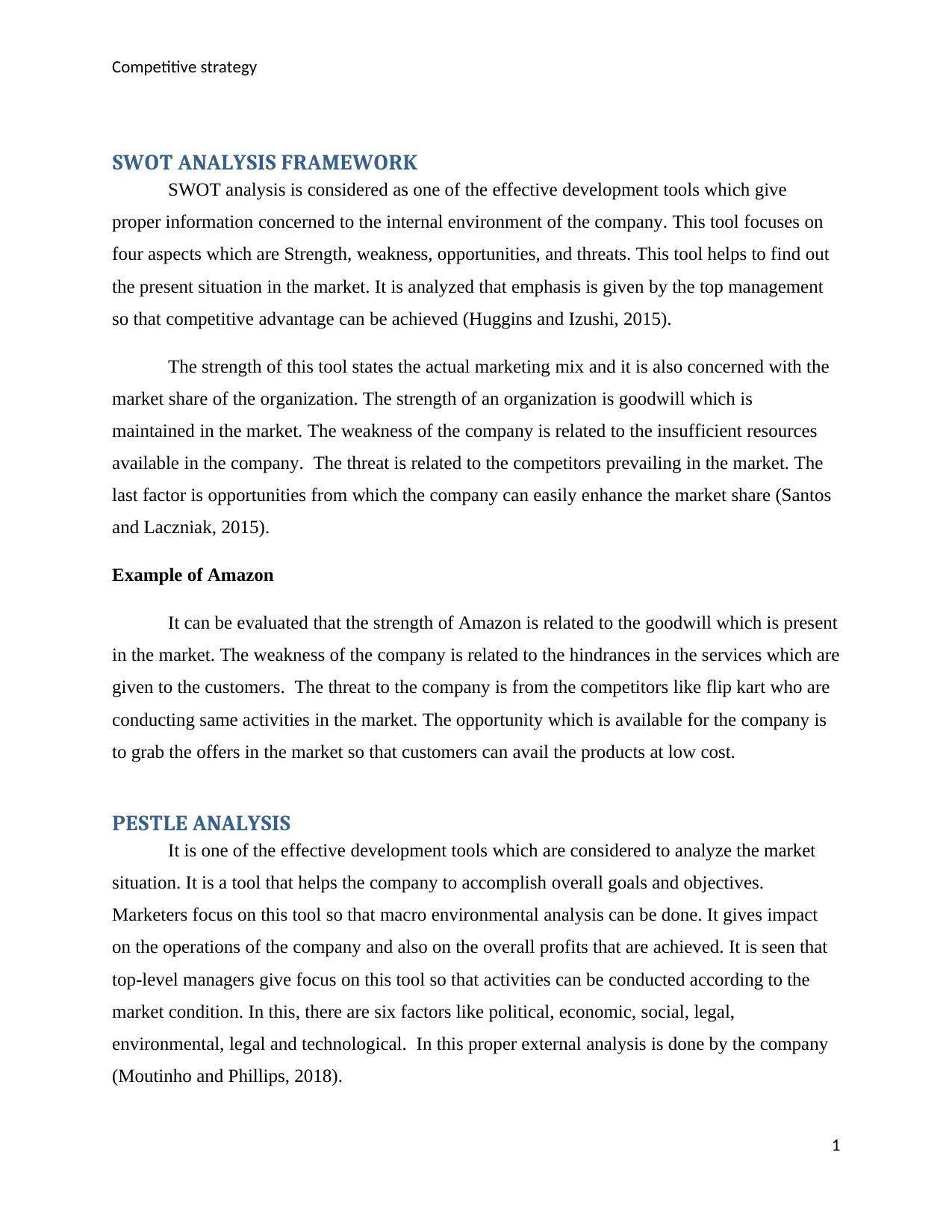
Competitive strategy
SWOT ANALYSIS FRAMEWORK
SWOT analysis is considered as one of the effective development tools which give
proper information concerned to the internal environment of the company. This tool focuses on
four aspects which are Strength, weakness, opportunities, and threats. This tool helps to find out
the present situation in the market. It is analyzed that emphasis is given by the top management
so that competitive advantage can be achieved (Huggins and Izushi, 2015).
The strength of this tool states the actual marketing mix and it is also concerned with the
market share of the organization. The strength of an organization is goodwill which is
maintained in the market. The weakness of the company is related to the insufficient resources
available in the company. The threat is related to the competitors prevailing in the market. The
last factor is opportunities from which the company can easily enhance the market share (Santos
and Laczniak, 2015).
Example of Amazon
It can be evaluated that the strength of Amazon is related to the goodwill which is present
in the market. The weakness of the company is related to the hindrances in the services which are
given to the customers. The threat to the company is from the competitors like flip kart who are
conducting same activities in the market. The opportunity which is available for the company is
to grab the offers in the market so that customers can avail the products at low cost.
PESTLE ANALYSIS
It is one of the effective development tools which are considered to analyze the market
situation. It is a tool that helps the company to accomplish overall goals and objectives.
Marketers focus on this tool so that macro environmental analysis can be done. It gives impact
on the operations of the company and also on the overall profits that are achieved. It is seen that
top-level managers give focus on this tool so that activities can be conducted according to the
market condition. In this, there are six factors like political, economic, social, legal,
environmental, legal and technological. In this proper external analysis is done by the company
(Moutinho and Phillips, 2018).
1
SWOT ANALYSIS FRAMEWORK
SWOT analysis is considered as one of the effective development tools which give
proper information concerned to the internal environment of the company. This tool focuses on
four aspects which are Strength, weakness, opportunities, and threats. This tool helps to find out
the present situation in the market. It is analyzed that emphasis is given by the top management
so that competitive advantage can be achieved (Huggins and Izushi, 2015).
The strength of this tool states the actual marketing mix and it is also concerned with the
market share of the organization. The strength of an organization is goodwill which is
maintained in the market. The weakness of the company is related to the insufficient resources
available in the company. The threat is related to the competitors prevailing in the market. The
last factor is opportunities from which the company can easily enhance the market share (Santos
and Laczniak, 2015).
Example of Amazon
It can be evaluated that the strength of Amazon is related to the goodwill which is present
in the market. The weakness of the company is related to the hindrances in the services which are
given to the customers. The threat to the company is from the competitors like flip kart who are
conducting same activities in the market. The opportunity which is available for the company is
to grab the offers in the market so that customers can avail the products at low cost.
PESTLE ANALYSIS
It is one of the effective development tools which are considered to analyze the market
situation. It is a tool that helps the company to accomplish overall goals and objectives.
Marketers focus on this tool so that macro environmental analysis can be done. It gives impact
on the operations of the company and also on the overall profits that are achieved. It is seen that
top-level managers give focus on this tool so that activities can be conducted according to the
market condition. In this, there are six factors like political, economic, social, legal,
environmental, legal and technological. In this proper external analysis is done by the company
(Moutinho and Phillips, 2018).
1
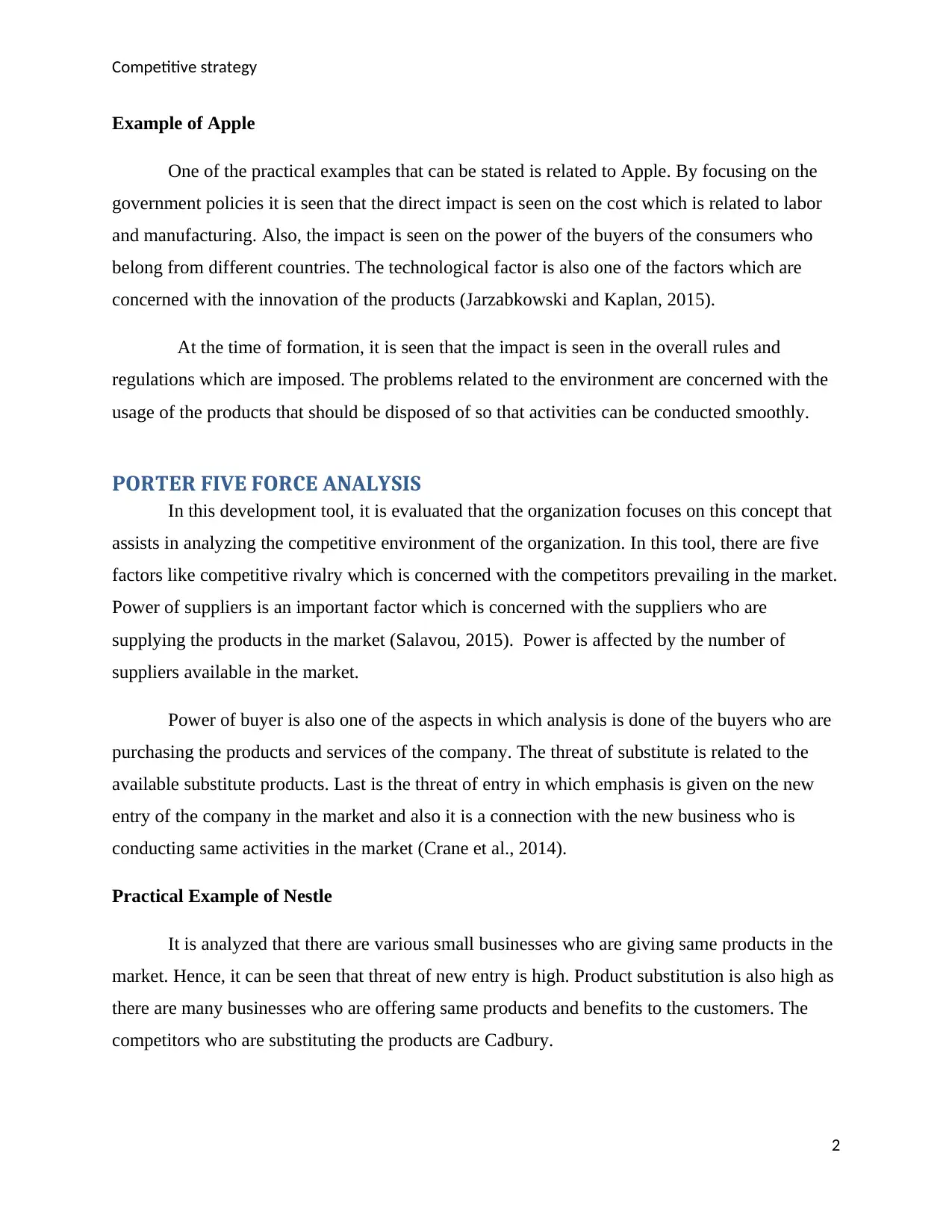
Competitive strategy
Example of Apple
One of the practical examples that can be stated is related to Apple. By focusing on the
government policies it is seen that the direct impact is seen on the cost which is related to labor
and manufacturing. Also, the impact is seen on the power of the buyers of the consumers who
belong from different countries. The technological factor is also one of the factors which are
concerned with the innovation of the products (Jarzabkowski and Kaplan, 2015).
At the time of formation, it is seen that the impact is seen in the overall rules and
regulations which are imposed. The problems related to the environment are concerned with the
usage of the products that should be disposed of so that activities can be conducted smoothly.
PORTER FIVE FORCE ANALYSIS
In this development tool, it is evaluated that the organization focuses on this concept that
assists in analyzing the competitive environment of the organization. In this tool, there are five
factors like competitive rivalry which is concerned with the competitors prevailing in the market.
Power of suppliers is an important factor which is concerned with the suppliers who are
supplying the products in the market (Salavou, 2015). Power is affected by the number of
suppliers available in the market.
Power of buyer is also one of the aspects in which analysis is done of the buyers who are
purchasing the products and services of the company. The threat of substitute is related to the
available substitute products. Last is the threat of entry in which emphasis is given on the new
entry of the company in the market and also it is a connection with the new business who is
conducting same activities in the market (Crane et al., 2014).
Practical Example of Nestle
It is analyzed that there are various small businesses who are giving same products in the
market. Hence, it can be seen that threat of new entry is high. Product substitution is also high as
there are many businesses who are offering same products and benefits to the customers. The
competitors who are substituting the products are Cadbury.
2
Example of Apple
One of the practical examples that can be stated is related to Apple. By focusing on the
government policies it is seen that the direct impact is seen on the cost which is related to labor
and manufacturing. Also, the impact is seen on the power of the buyers of the consumers who
belong from different countries. The technological factor is also one of the factors which are
concerned with the innovation of the products (Jarzabkowski and Kaplan, 2015).
At the time of formation, it is seen that the impact is seen in the overall rules and
regulations which are imposed. The problems related to the environment are concerned with the
usage of the products that should be disposed of so that activities can be conducted smoothly.
PORTER FIVE FORCE ANALYSIS
In this development tool, it is evaluated that the organization focuses on this concept that
assists in analyzing the competitive environment of the organization. In this tool, there are five
factors like competitive rivalry which is concerned with the competitors prevailing in the market.
Power of suppliers is an important factor which is concerned with the suppliers who are
supplying the products in the market (Salavou, 2015). Power is affected by the number of
suppliers available in the market.
Power of buyer is also one of the aspects in which analysis is done of the buyers who are
purchasing the products and services of the company. The threat of substitute is related to the
available substitute products. Last is the threat of entry in which emphasis is given on the new
entry of the company in the market and also it is a connection with the new business who is
conducting same activities in the market (Crane et al., 2014).
Practical Example of Nestle
It is analyzed that there are various small businesses who are giving same products in the
market. Hence, it can be seen that threat of new entry is high. Product substitution is also high as
there are many businesses who are offering same products and benefits to the customers. The
competitors who are substituting the products are Cadbury.
2
⊘ This is a preview!⊘
Do you want full access?
Subscribe today to unlock all pages.

Trusted by 1+ million students worldwide
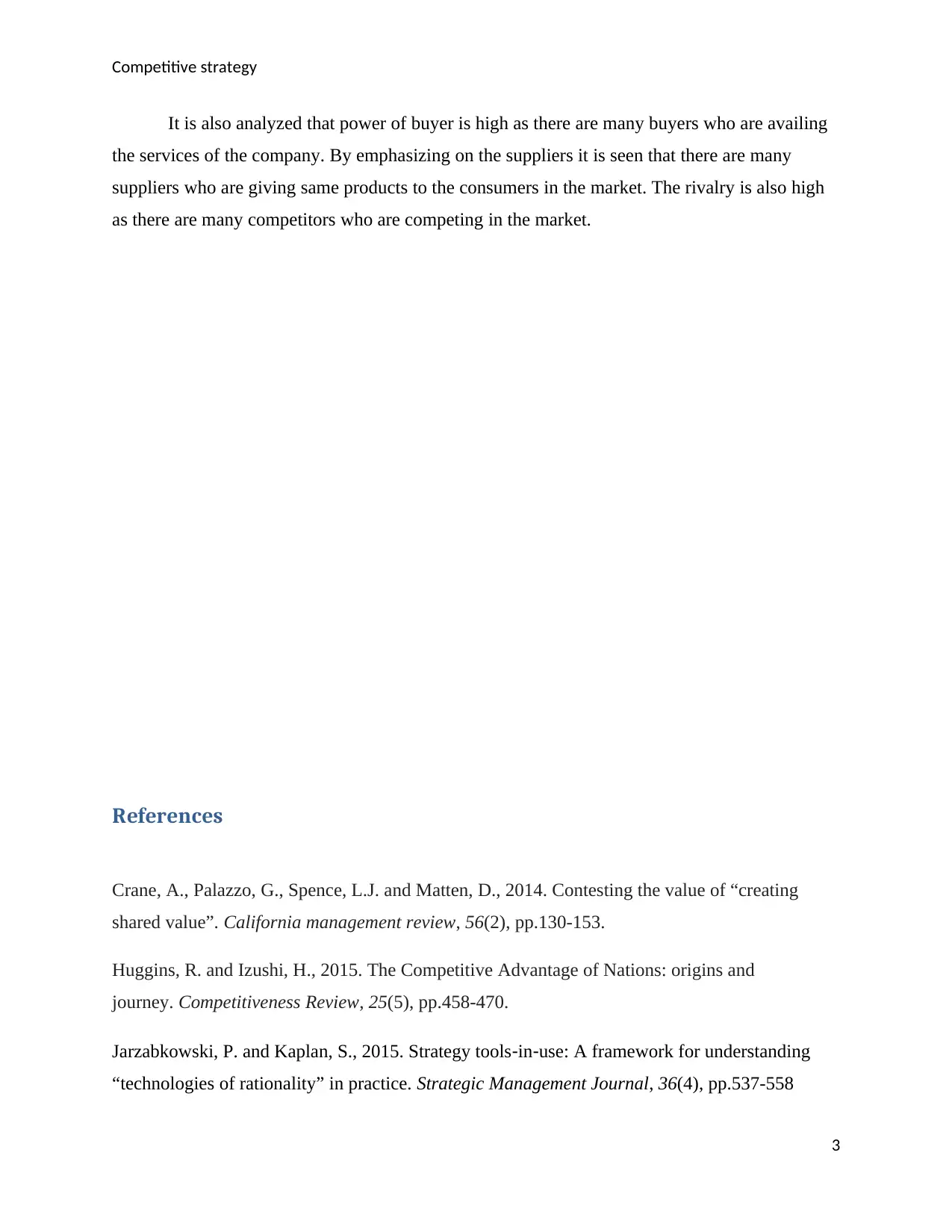
Competitive strategy
It is also analyzed that power of buyer is high as there are many buyers who are availing
the services of the company. By emphasizing on the suppliers it is seen that there are many
suppliers who are giving same products to the consumers in the market. The rivalry is also high
as there are many competitors who are competing in the market.
References
Crane, A., Palazzo, G., Spence, L.J. and Matten, D., 2014. Contesting the value of “creating
shared value”. California management review, 56(2), pp.130-153.
Huggins, R. and Izushi, H., 2015. The Competitive Advantage of Nations: origins and
journey. Competitiveness Review, 25(5), pp.458-470.
Jarzabkowski, P. and Kaplan, S., 2015. Strategy tools‐in‐use: A framework for understanding
“technologies of rationality” in practice. Strategic Management Journal, 36(4), pp.537-558
3
It is also analyzed that power of buyer is high as there are many buyers who are availing
the services of the company. By emphasizing on the suppliers it is seen that there are many
suppliers who are giving same products to the consumers in the market. The rivalry is also high
as there are many competitors who are competing in the market.
References
Crane, A., Palazzo, G., Spence, L.J. and Matten, D., 2014. Contesting the value of “creating
shared value”. California management review, 56(2), pp.130-153.
Huggins, R. and Izushi, H., 2015. The Competitive Advantage of Nations: origins and
journey. Competitiveness Review, 25(5), pp.458-470.
Jarzabkowski, P. and Kaplan, S., 2015. Strategy tools‐in‐use: A framework for understanding
“technologies of rationality” in practice. Strategic Management Journal, 36(4), pp.537-558
3
Paraphrase This Document
Need a fresh take? Get an instant paraphrase of this document with our AI Paraphraser
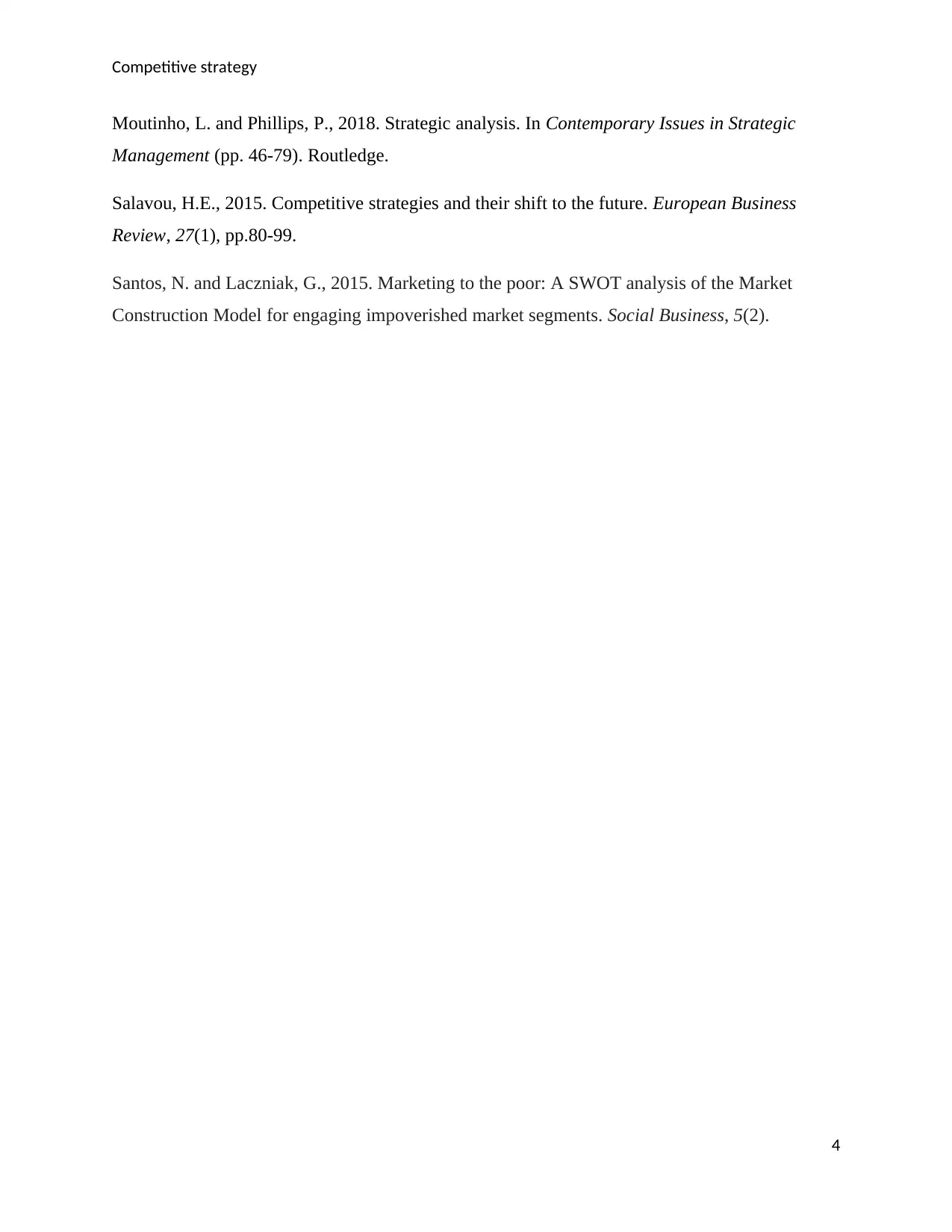
Competitive strategy
Moutinho, L. and Phillips, P., 2018. Strategic analysis. In Contemporary Issues in Strategic
Management (pp. 46-79). Routledge.
Salavou, H.E., 2015. Competitive strategies and their shift to the future. European Business
Review, 27(1), pp.80-99.
Santos, N. and Laczniak, G., 2015. Marketing to the poor: A SWOT analysis of the Market
Construction Model for engaging impoverished market segments. Social Business, 5(2).
4
Moutinho, L. and Phillips, P., 2018. Strategic analysis. In Contemporary Issues in Strategic
Management (pp. 46-79). Routledge.
Salavou, H.E., 2015. Competitive strategies and their shift to the future. European Business
Review, 27(1), pp.80-99.
Santos, N. and Laczniak, G., 2015. Marketing to the poor: A SWOT analysis of the Market
Construction Model for engaging impoverished market segments. Social Business, 5(2).
4
1 out of 5
Related Documents
Your All-in-One AI-Powered Toolkit for Academic Success.
+13062052269
info@desklib.com
Available 24*7 on WhatsApp / Email
![[object Object]](/_next/static/media/star-bottom.7253800d.svg)
Unlock your academic potential
Copyright © 2020–2025 A2Z Services. All Rights Reserved. Developed and managed by ZUCOL.




